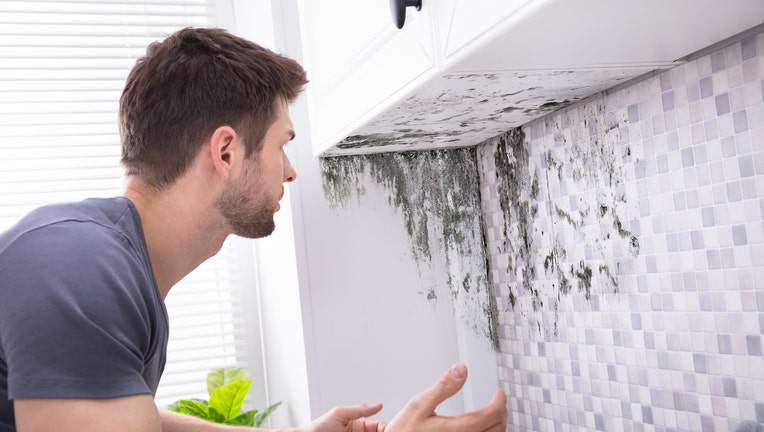Is mold coverage included in my homeowners insurance policy?

Mold can be hazardous to your health and your finances. (iStock)
Mold is a kind of fungus that grows when it's around moisture. People are exposed to mold and its spores on a daily basis but that exposure is typically harmless in small doses. But if your home becomes a haven for mold, it could increase your risk of getting sick, especially if you’re allergic.
If mold is in your home, it’s often found in the kitchen, bathroom, laundry room, basement or crawl space. Unlike mildew, mold isn’t easily cleaned up with household cleaning products. Once you find it, it’s crucial to get rid of it as quickly as possible. But will your homeowners insurance policy help? It can, but it’s not guaranteed.
You can head to Credible to get a better understanding of the different types of home insurance coverage. Click on Credible's home insurance partners to get a free home insurance quote.
DOES HOMEOWNERS INSURANCE COVER A TREE FALLING ON YOUR HOUSE?
Do all homeowners insurance provide mold coverage?
Mold isn’t directly covered by homeowners insurance. However, you may be able to get reimbursed for its removal if it was caused by something that your insurance policy does cover.
"Covered perils that can cause mold damage typically include house fire, failure of a plumbing system like frozen pipes and failure of a heating or cooling system," Daniel Sperling-Horowitz, CEO of OfferMarket, an online real estate marketplace, said.
In some cases, mold can be caused by flooding. But since standard homeowners insurance policies don’t cover flooding, you’d need a flood insurance policy to ensure that you’re protected in that event, Sperling-Horowitz added.
Your homeowners insurance policy will not cover mold if it was caused by negligence. For example, if a pipe in your basement bursts but you don’t discover it for a couple of weeks, your dilapidated roof begins to leak because it hasn’t been repaired in years or you discover mold in the shower because it hasn’t been cleaned in several weeks.
If you're looking for new insurance but need help, Credible can walk you through each homeowners insurance policy and coverage. Plus, they can tell you how to save hundreds on homeowners insurance each year.
DOES HOME INSURANCE COVER NATURAL DISASTERS?
How do you find the right coverage for mold?
Standard homeowners insurance policies will provide financial protection as long as the fungus growth was caused by a covered peril. However, there are some exceptions to that rule.
In some cases, an insurance policy can have additional language that provides limited coverage for mold damage. If that’s the case, there will typically be limitations, such as how much and which types of services the insurance company will cover.
You may also be able to purchase an endorsement, which provides mold coverage for an additional fee. Check with your insurer to understand your options.
Having enough insurance is vital. Having the appropriate insurance coverage is just as important. To ensure your insurance is suitable for your circumstances, visit Credible to check out plans, providers and costs.
DOES HOME INSURANCE COVER RENTAL PROPERTY?
How do you make a mold insurance claim?
In many cases, you may feel the effects of mold before you see it. Congestion, difficulty breathing and eye irritation are all symptoms that could signal that you have a mold problem — and things can get worse if you don’t address it.
The longer you let the mold grow, the harder it will be to deal with it. So make it a priority as soon as you find out what’s going on.
If you’re thinking of filing a claim, make sure you document everything you can, including how the mold came to be. This may be easy if you experienced a major water impact event in your home, such as a burst pipe or storm.
If you have bills for services rendered to fix those issues, include them in your claim. Also, take photographs of the damage and include pictures of prior water damage if you think that’s what caused it.
If you’re not sure what caused the mold to occur, hire a professional to do a mold analysis to determine the source of the mold and moisture. Other important steps include:
- Contact your insurance company as soon as possible.
- Do what you can to prevent further mold growth, such as purchasing a dehumidifier or fan and opening windows.
- Avoid trying to clean up the area until the insurance adjuster has assessed the damage and given you the information you need about coverage.
Remember, it’s possible that your insurance policy won’t cover mold remediation at all so be prepared to take care of it alone if you have to. But it’s crucial that you act quickly.
"Mold that is allowed to spread unchecked can quickly become expensive to remediate," Sperling-Horowitz said. "What can cost $500 or less to resolve can quickly balloon into a $5,000 to $10,000-plus expense if you allow it to spread through the house."
The bottom line
Mold can be expensive to remove but your insurance provider might be able to help. Read the fine print of your policy to find out if you have mold insurance. If you don’t find anything, shop around and compare other policies to see if you can find one that will cover it.
You can shop around for homeowners insurance policies through Credible, where you can compare homeowners insurance quotes from multiple insurers in one place.

